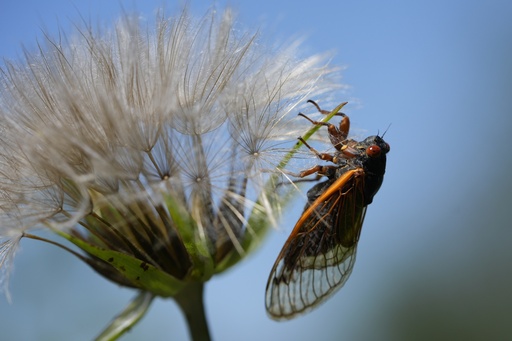WHEATON, Ill. (AP) — The most noticeable part of the cicada invasion blanketing the central United States is the sound — an eerie, amazingly loud song that gets in a person’s ears and won’t let much else in.
“It’s beautiful chaos,” said Rebecca Schmidt, a U.S. Department of Agriculture research entomologist. “It does make this kind of symphony.”
The songs — only from males — are mating calls. Each periodical cicada species has its own distinct song, but two stand out: those of the orange-striped decims or pharaoh cicadas, and the cassini cicada, which is smaller and has no orange stripes on its belly.
“The one we’re hearing the most is the cassini, a buzzy trail that goes up in a wave and is coming back down,” Jennifer Rydzewski, an insect ecologist at DuPage County Forest Preserve, said in an interview in a clearing near a bunch of trees.
“And every time it goes up in a wave and comes back down, you’ll see in the treetops a bunch of them start flying out, so they’ll make a call and then jump to a new branch and make the call again. So it’s actually like different groups that are coming in waves.”
The other one is a “constant whirring hum, which is the pharaoh’s staccato” and every now and then an individual call that sounds like “eee-ooo” can be heard, she said. Others have said the sound is more like “fffaaaro, fffaaaro.”
The sound comes from a white membrane on the male’s midsection that is made to vibrate, Schmidt and Rydzewski said. The area beneath it acts like an echo chamber.
“It’s a lot of the same sort of physics as an instrument,” Schmidt said. “So if you think about like a drum, you can have a pretty small drum that is being hit by somebody that’s not hitting it that hard, and it still makes quite a lot of noise.”
___
Read more of AP’s climate coverage at http://www.apnews.com/climate-and-environment
___
Follow Seth Borenstein on X at @borenbears
___
The Associated Press’ climate and environmental coverage receives financial support from multiple private foundations. AP is solely responsible for all content. Find AP’s standards for working with philanthropies, a list of supporters and funded coverage areas at AP.org.
This website uses cookies so that we can provide you with the best user experience possible. Cookie information is stored in your browser and performs functions such as recognising you when you return to our website and helping our team to understand which sections of the website you find most interesting and useful.
